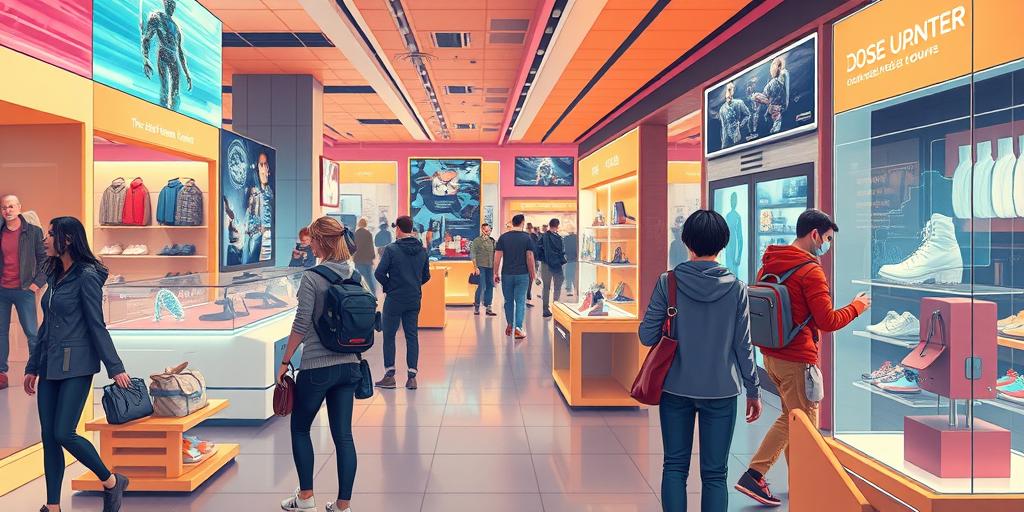Prepare to be amazed! The retail landscape is on the brink of a breathtaking transformation, and it’s all thanks to the relentless march of digital technology. By 2030, the shopping experience as we know it will be utterly unrecognizable, a captivating blend of physical and digital realms that will redefine convenience and customer engagement. Get ready to explore the incredible ways digital transformation is set to revolutionize the retail industry. This isn’t just about online shopping; it’s a complete overhaul that will leave you speechless!
The Rise of the Metaverse and Immersive Shopping Experiences
Imagine trying on clothes without even leaving your house, or taking a virtual tour of your dream furniture store from the comfort of your couch. This isn’t science fiction; this is the immersive shopping experience powered by the metaverse. Retailers are already experimenting with virtual showrooms and augmented reality (AR) apps that let customers visualize products in their own homes before buying. In 2030, this technology will be seamlessly integrated into the shopping journey, offering unparalleled convenience and a level of personalization never before seen. Customers will be able to interact with products in lifelike detail, experiencing the texture of fabrics or the heft of electronics without ever physically touching them. The development of haptic suits and advanced sensory technologies will only enhance this immersion, creating truly unforgettable shopping experiences. The combination of Virtual Reality (VR) and Augmented Reality (AR) technologies in the retail sector will be a game-changer, offering the best of both worlds.
Enhanced Customer Engagement through Virtual Try-Ons and Interactive Experiences
Virtual try-on technology has already begun to make inroads into the fashion industry, and by 2030, it will be a standard feature in most online and in-store shopping experiences. Customers will be able to try on clothes, shoes, and accessories virtually, eliminating the hassle of changing rooms and returns. Interactive experiences, such as virtual fashion shows and product demonstrations, will further enhance customer engagement and create a sense of community. Moreover, the use of artificial intelligence (AI) will help retailers personalize these experiences, tailoring product recommendations and virtual try-ons to individual customer preferences. The future of retail shopping will depend on such immersive virtual shopping technologies.
AI-Powered Personalization and Predictive Analytics
Forget generic marketing campaigns; the future of retail is hyper-personalization. AI-powered systems will analyze customer data to understand individual preferences, shopping habits, and even emotional responses. This level of insight will allow retailers to deliver targeted recommendations, create bespoke marketing messages, and even predict future purchasing behavior. This will not only increase sales but also enhance customer satisfaction by providing a more relevant and engaging shopping experience. Predictive analytics will anticipate customer needs and desires, enabling retailers to optimize inventory, personalize promotions, and proactively address customer service issues before they even arise. Such AI-powered personalization will make shopping more intuitive and efficient.
The Impact of Data Analysis on Inventory Management and Personalized Marketing
The massive amount of data collected will allow retailers to optimize their supply chain, reduce waste, and improve inventory management. By analyzing purchase patterns and predicting future demand, retailers can ensure that they have the right products in the right place at the right time. This will drastically reduce stockouts and overstocking, leading to significant cost savings and increased profitability. Personalized marketing campaigns, tailored to each customer’s individual preferences, will deliver better results than mass marketing approaches, increasing conversion rates and customer loyalty.
The Seamless Integration of Online and Offline Channels: Omni-Channel Retailing
The lines between online and offline shopping will become increasingly blurred as retailers adopt omni-channel strategies. This means that customers will be able to seamlessly transition between online and offline channels throughout their shopping journey. They might start their search online, browse products in a physical store, and then complete their purchase online or vice-versa. This level of flexibility will provide customers with unparalleled convenience and control. Omni-channel retail strategies will create a truly integrated and unified brand experience for customers. The future of retail lies in providing a consistently exceptional customer journey across various touchpoints.
Click-and-Collect, Curbside Pickup, and In-Store Returns
Services such as click-and-collect, curbside pickup, and in-store returns will become standard practice, providing customers with greater flexibility and convenience. These options are already popular, but in 2030, they will be fully integrated into the shopping experience, making it easier than ever to purchase and return items. For example, customers may be able to schedule a specific time for curbside pickup or easily return items to any location that is convenient for them, regardless of where they made the original purchase. This kind of seamless integration will make shopping a smoother, more customer-friendly experience.
Sustainable and Ethical Retail Practices
Consumers are increasingly conscious of the environmental and social impact of their purchasing decisions. In 2030, sustainability and ethical considerations will be central to retail operations. Retailers will focus on reducing waste, using eco-friendly materials, and supporting ethical suppliers. Transparency and traceability will be key, allowing consumers to make informed choices about the products they buy. Sustainable packaging and efficient delivery systems will further reduce the environmental impact of retail operations, making it easy for consumers to make environmentally-friendly purchasing decisions. This focus on sustainability will appeal to the growing number of consumers who are concerned about the environment and the ethical treatment of workers.
Ready to embrace the future of retail? The digital revolution is upon us, and it’s transforming the way we shop in ways you’ve never imagined!




